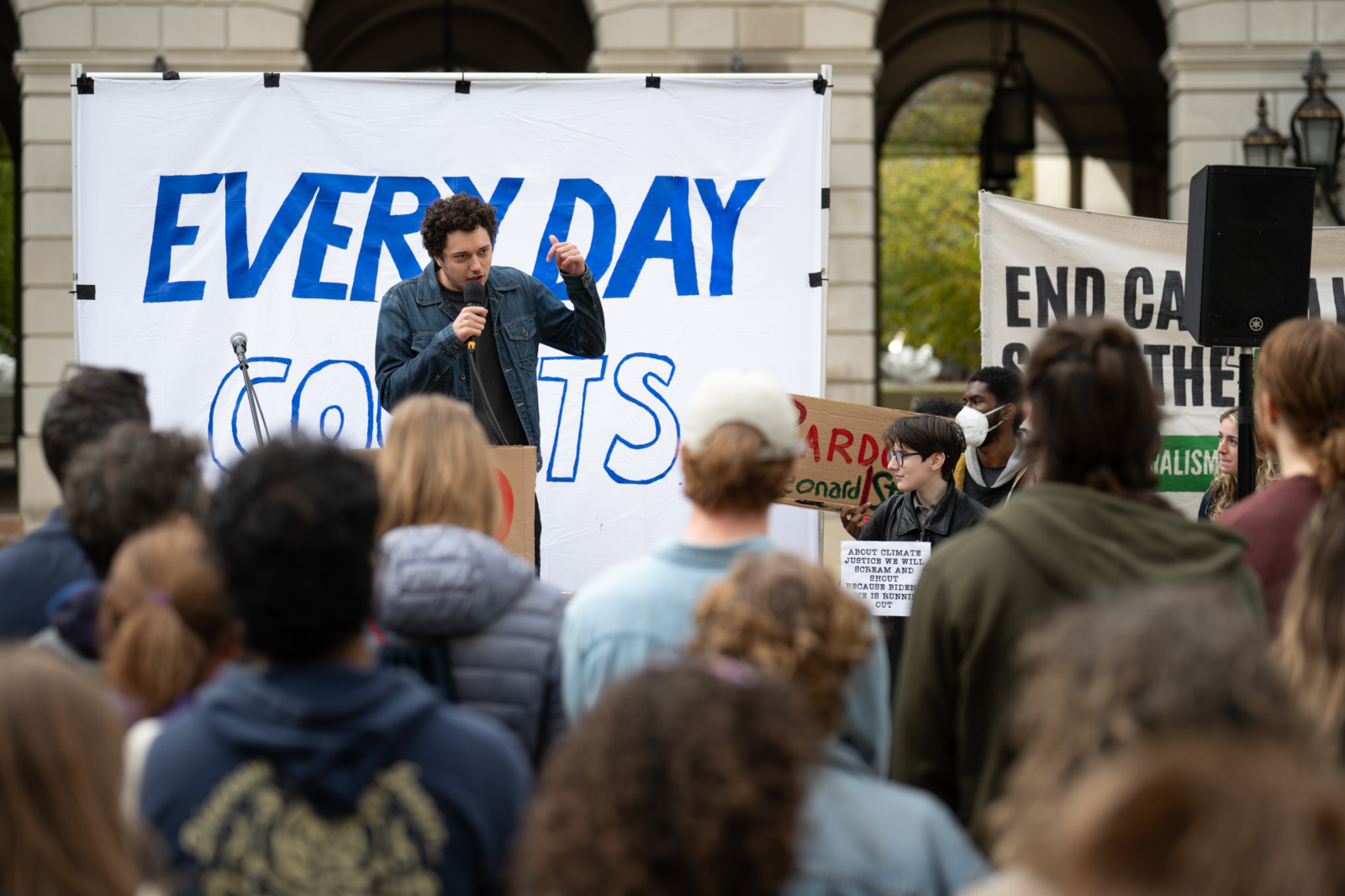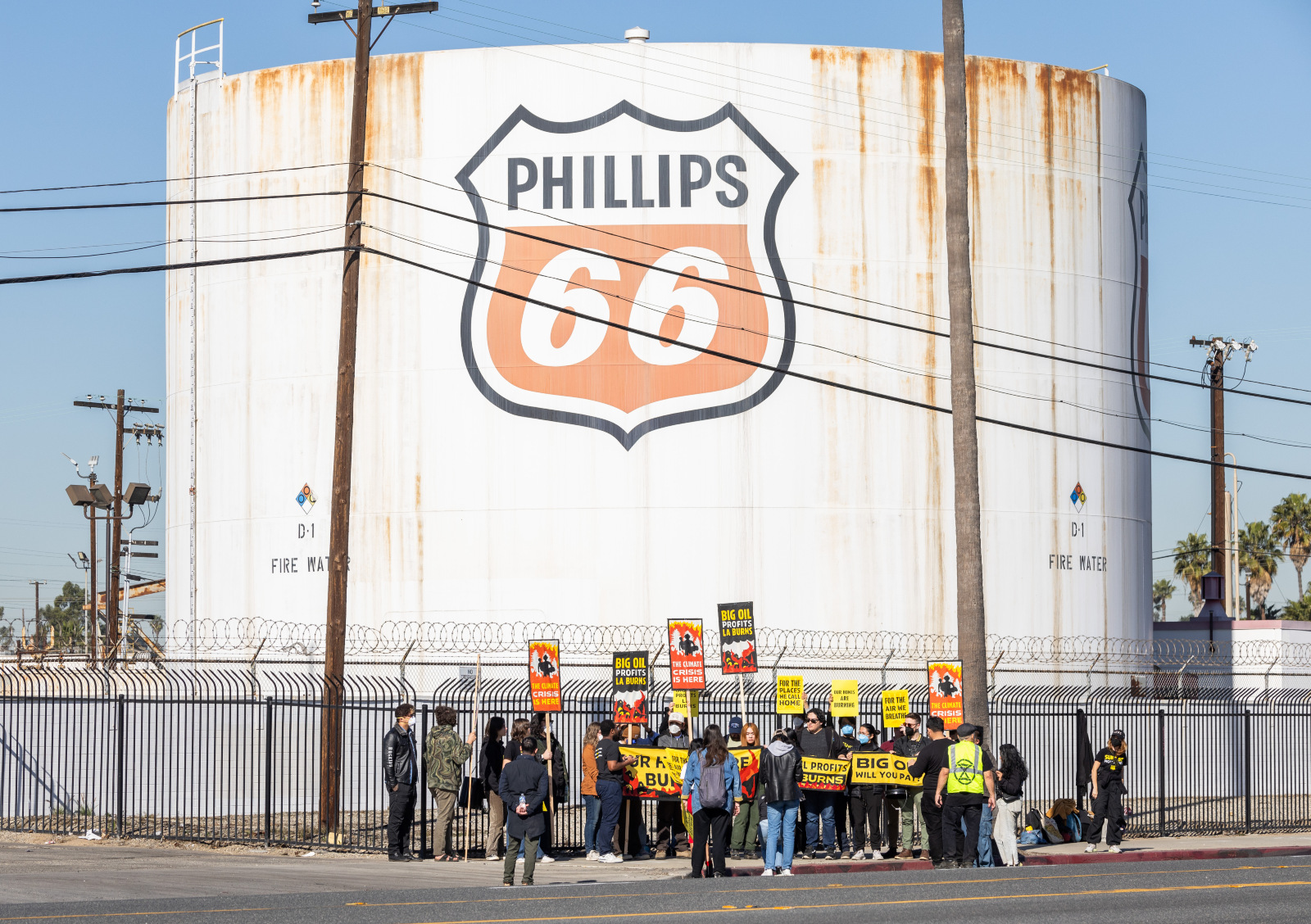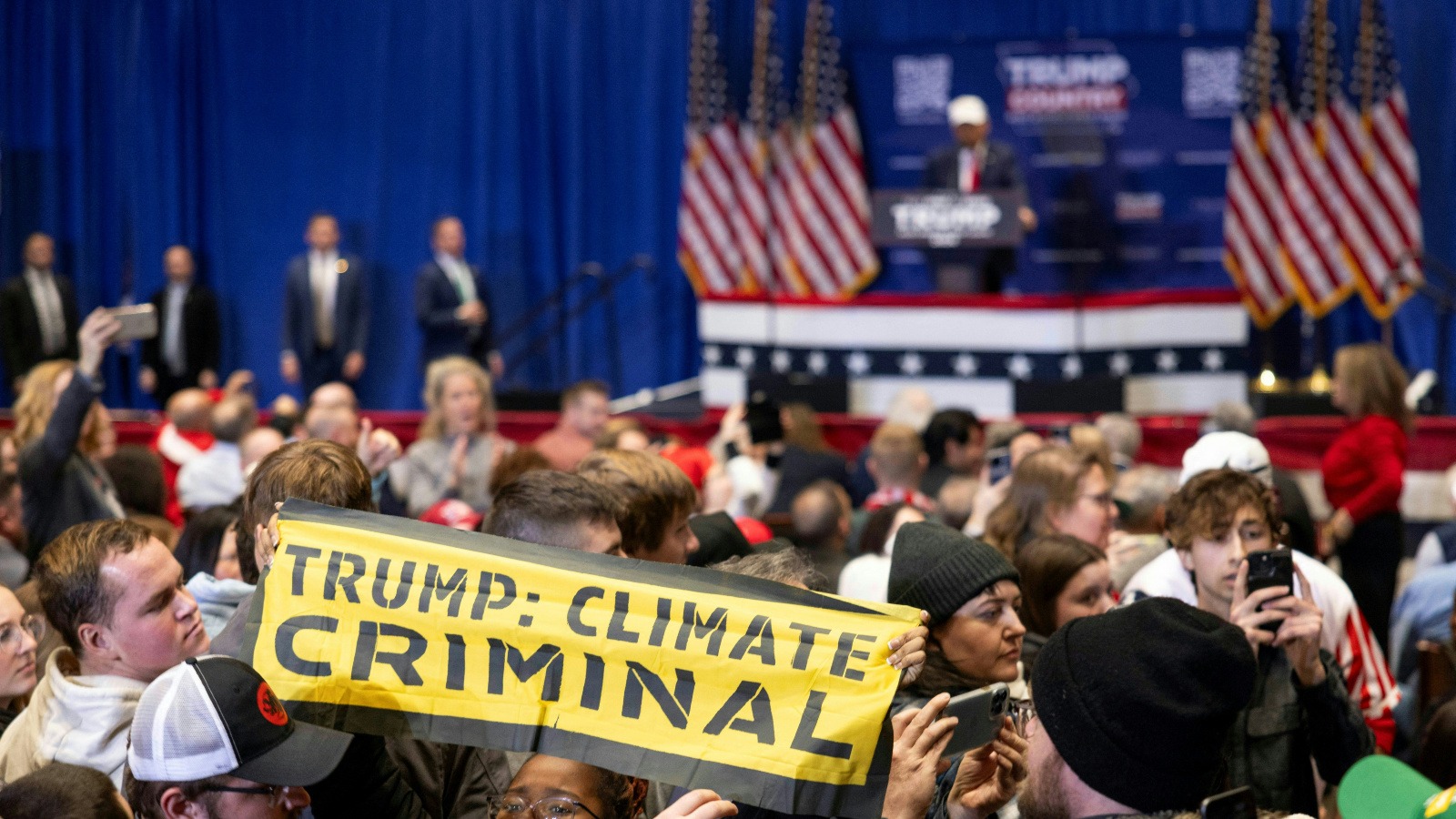The movement to demand action on climate change took a new turn on October 14, 2022, the day that a pair of activists in London’s National Gallery tossed tomato soup at the glass in front of Vincent van Gogh’s “Sunflowers” painting.
Most people didn’t like the spectacle, an attempt to grab public attention by vandalizing a celebrated work of art, but that was kind of the point. After decades of peaceful protests, climate activists hadn’t gotten anything close to what they wanted. Even as people around the world had begun to experience the sobering effects of climate change firsthand — sweating through heat waves and breathing in acrid smoke from wildfires — global carbon dioxide emissions were still increasing, and elected governments were still signing off on new oil and gas projects. Activists felt like they had to try something different: What could they do to shake things up and get people’s attention?
That question is only becoming more pressing as President Donald Trump begins his second term in office, declaring an “energy emergency” in his inaugural address on Monday to expand fossil fuel production. “This moment is so incredibly far from anywhere close to even where we want to be fighting on,” said Keanu Arpels-Josiah, a 19-year-old organizer with Fridays for Future NYC, a youth-led climate activist group, in the days after the November presidential election.
When Trump entered the White House for the first time in 2017, climate activism was infused with a fresh wave of energy, building on the momentum of the broader “American Resistance” that rose up against his policies. A movement once tied to pipeline protests and university divestment started attracting widespread attention, with brand-new groups led by young people like the Sunrise Movement and Zero Hour staging marches and occupying Congressional offices. The Swedish teenager Greta Thunberg started skipping school on Fridays in 2018 to protest the lack of government action, inspiring teenagers around the world to participate in “school strikes.” Calling for a “Green New Deal” became a popular slogan among progressives.
But when President Joe Biden took office in 2021, some of that energy fizzled out, and the climate movement fractured. Big environmental organizations like the Sierra Club tried to influence federal policy — and succeeded for once, with Congress passing the largest investment in climate action in United States history in 2022 — while radical grassroots activists from Climate Defiance demanded more, heckling the White House climate adviser, Ali Zaidi, on multiple occasions.
“We were seeing this crazy, very, very fractured climate movement, which was in abeyance, where most Americans, while they said they cared about climate change, were not willing to march in the streets for it,” said Dana Fisher, a professor at American University who has studied climate activism for more than two decades. “That all is over.”
With Trump back in the White House, she expects climate advocates will start working together again, alongside people representing other progressive causes, since they’ll have a common enemy. “Will the Resistance rise again? Yes,” Fisher said. “Will the Resistance look the same? Absolutely not.”
Halil Sagirkaya / Anadolu via Getty Images
The first sign that progressive activists would respond to the new Trump administration by banding together came two days before the presidential inauguration, when an estimated 50,000 people participated in the People’s March in Washington, D.C., on January 18, protesting for reproductive rights, LGBTQ+ rights, and racial justice, along with other causes. Of the 453 protesters that Fisher’s team surveyed at the event, 70 percent named climate change as one of their top motivations for participating.
“All the different things we’re fighting for really are under attack,” Arpels-Josiah said. “I think we have no other option than to organize in a moment like this, right?” His organization, Fridays for Future NYC, is planning to hold a Youth Climate Justice Convergence on March 1 to discuss how to push for change in New York at the local and state level.
Climate activists expressed an appetite to try something new, but they haven’t nailed down an overall strategy for the next four years. “There’s definitely a sentiment that we’ve struggled to turn marches and mass mobilizations in one place into meaningful political change that changes people’s lives,” said Saul Levin, the director of campaigns and politics at the Green New Deal Network, a coalition of climate, labor, and justice organizations. “And so it’s not that we’re giving up on those methods, but we’re testing out different things.” Levin didn’t offer specifics about what the coalition will try out, but said he wouldn’t rule any tactics out, since there are different approaches across the movement.
In recent years, activists have blocked traffic in streets, spray-painted Stonehenge, and interrupted events to shame politicians they call “climate criminals.” These are signs that the climate movement is growing a “radical flank,” an offshoot that’s more confrontational and more disruptive. Experts say civil disobedience, even if it alienates people, can sometimes serve to focus attention on a cause and make tamer protests appear more socially acceptable. It’s not the same as establishing cause and effect, but anecdotes suggest there’s something to the idea. Two weeks after activists with Just Stop Oil spent a week blocking traffic in London in November 2022, for instance, surveys found that people in the United Kingdom were more likely to support the more moderate group Friends of the Earth, according to a study last fall.
“Climate activists will absolutely be staying peaceful, but they will not be staying non-disruptive,” Fisher said. A Trump administration hostile to action could provide more fuel for groups like Climate Defiance, whose activists frequently get arrested for confronting oil executives and politicians.

Andrew Derek Strachan
Of course, civil disobedience is just one tool among many, and activists are leaning into more popular forms of organizing, like rallies, in order to attract a big crowd. “We need everyone right now, and to build real power on climate justice, we need a bigger coalition than we’ve ever had or ever seen,” Levin said at a mass organizing call for climate groups the day after the inauguration. “And that starts by gathering people in communities to build power for people by people.” In February, the Climate Action Campaign, a coalition of environmental and health organizations, plans to hold “Climate Can’t Wait” rallies in Atlanta, Pittsburgh, and Detroit, hoping to “mobilize the largest possible number of people to demand action.”
Aru Shiney-Ajay, the executive director of the Sunrise Movement, has been working with organizers in Los Angeles on a number of actions in response to the devastation brought by recent wildfires. In the week before the presidential inauguration, members from the L.A. hub of Sunrise led a multi-day demonstration outside of the Phillips 66 oil facility in Carson, California, demanding that fossil fuel companies “pay up” for their contributions to the climate crisis, which made recent fires more dangerous.
“If we are to have any hope at truly winning, at truly turning the tides of society, at moving our economy away from the most powerful industry in history, the fossil fuel industry, we must build up the organizing power that it takes to actually disrupt the people in power,” Shiney-Ajay said during the call for climate groups.
Over the course of the five-day protest outside the Phillips 66 facility, neighbors stopped by to show their support — and even the oil refinery’s guards told the group they agreed with them, according to Shiney-Ajay. “Those are the moments that felt the most meaningful,” she said. In the aftermath of the wildfires, the sit-in created an opportunity to meet “people who had never encountered the climate movement at their doorstep before finding themselves in support.”

Myung J. Chun / Los Angeles Times via Getty Images
The Sunrise Movement is drawing inspiration from historical examples of people successfully agitating for change, such as the Civil Rights Movement’s Montgomery bus boycotts of the 1950s, and the United Auto Workers Union strikes in Michigan in the 1930s, according to Dejah Powell, Sunrise’s membership director. “When we look at change and transformation [in society], a lot of it has come from labor: 40-hour workweek, the weekend, paid sick leave,” she said. “It comes from disrupting or threatening capital.”
Powell said the organization is looking to build on the success of the Friday school strikes that began in 2018, experimenting with sustained, month-long student strikes. The group also seems poised to expand its direct action efforts: Members of Sunrise recently interrupted the confirmation hearing for Trump’s nominee to run the Energy Department, Chris Wright, the CEO of a fracking company. No politician is off-limits, said Shiney-Ajay. “We have a saying: ‘No permanent friends, no permanent enemies.’” The executive director said the organization is open to an array of tactics, though it draws the line at violent protest.
Despite the peaceful nature of these kinds of demonstrations, Fisher says climate organizers should prepare for a crackdown on protests, with the potential for repression and violence. “I think that what we’re going to see is the Trump administration pushing back and pushing back hard against civil disobedience for sure, and potentially all forms of protest,” she said. “And that is going to quickly escalate what’s going to happen on the streets.” On top of that, over the past decade, more than 20 states have passed laws increasing penalties for protesting near so-called critical infrastructure such as oil and gas facilities, now sometimes punishable by years in prison.
Some of the training that climate activists have been participating in over the past couple of months has focused on nonviolent direct action and defusing tense situations, according to Levin from the Green New Deal Network. “We think that we need a new set of tools and refreshed trainings, because no one can fully predict the level of chaos and repression that’s going to come from this extremist administration.”
Amid that chaos, the climate movement will be looking not just for new tactics, but also an updated message. Some of the economic concerns that are credited with driving Trump into the presidency, such as inflation and the rising cost of living, are connected to climate change, Levin said. The fires in L.A. are one example of how disasters like these threaten people’s livelihoods and financial security, he said. “We’ve talked about these things for years, but we need to update how we’re talking about them.”
Shiney-Ajay sees the L.A. wildfires as an opportunity to connect the dots between the climate crisis and other pressures facing the city, like runaway rent prices and a need for more resilient infrastructure, as well as a chance to bring more people into the movement. “People want to believe something will work or have something to believe in,” she said. Actions like the one at the Phillips 66 oil refinery help with that.
“Here is a way we can respond after disasters that is humane and kind and makes your life better and helps you believe in your government, helps you believe in a better world,” Shiney-Ajay said. The movement’s task will be to “hold that up in contrast to the vision of the world that Trump is proposing.”
Source link
Kate Yoder grist.org


